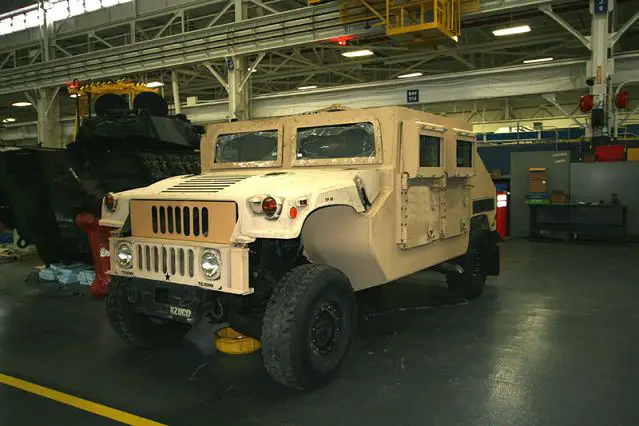| a | |||
Defense Industry Technology - Humvee blast protection |
|||
| Thursday, December 5, 2013 07:24 AM | |||
| United States army develops new add-on armour to increase crew survivability of HMMWVs. | |||
| High
Mobility Multipurpose Wheeled Vehicles (HMMWVs) were among the first vehicles
to enter conflict zones in Iraq and Afghanistan. When it became clear
this would be a different kind of war, one where tactical vehicles like
HMMWVs would need added protection, engineers developed bolt-on armor
kits to increase crew survivability. |
|||
 New survivability armour for HMMWV features on the upgraded Blast Cab include aluminum armor, triple-V hull design and lower center of gravity. |
|||
| |
|||
TARDEC engineers have again responded to a user request, this time to identify potential future survivability upgrades for the HMMWV fleet, keeping Soldiers safer in the field. They designed a prototype solution for HMMWVs that could be integrated into the manufacturing process using aluminum-based armor and a triple-V hull underneath to build stronger layers of protection against blasts and small arms fire. The weight of the integrated armor forming the new cab still meets Army requirements for the vehicle, TARDEC Center for Systems Integration Associate Director, Engineered Solutions, John J. Schmitz stated. "This armor is designed for the crew to survive a blast," Schmitz pointed out. "The aluminum armor solution proved to be the key because you can only load so much weight on an HMMWV chassis. The prototype vehicle is the same weight but with significantly increased survivability." Today's Mine-Resistant Ambush-Protected (MRAP) vehicles deliver greater protective capability than the HMMWV, and the future Joint Light Tactical Vehicle will dramatically improve balanced payload, performance and protection. But the Army will continue using HMMWVs for decades and plans to insert mature technologies at the right times. The HMMWV may require survivability upgrades for future conflicts, and examining the art of the possible in the new Blast Cab rises to that challenge. "In case of an extreme situation where we are back in decisive combat before JLTVs are ready and we are unable to deploy MRAPs, we need to have proven solutions on the shelf," commented COL John Cavedo, Product Manager Joint Program Office Joint Light Tactical Vehicles (PM JLTV). Engineers in TARDEC's Ground Systems Engineering Assessment and Assurance group performed modeling and simulation research to confirm the Blast Cab team's design and structural changes. Also, engineers in the Occupant Protection Laboratory at Selfridge Air National Guard Base conducted Sub-System Drop Tower tests to validate the seats, which are hinged to partially absorb blast energy. The cab flooring includes a crush zone area under passengers' feet to add protection near the blast point. Other survivability factors include the chassis height — engineers raised it to provide more stand-off margin under the vehicle to better mitigate a blast. And they lowered the center of gravity as much as possible with design features such as a lower tunnel area and thinner roof plate. These features make the vehicle less top-heavy and less vulnerable to rollovers or flipovers in an attack. The triple-V hull design channels blast energy away from the crew compartment and limits how far the vehicle can be thrown in the air. Both effects should reduce the risk of Soldier casualties. "It was gratifying to see our TARDEC partners go from concept designs to a prototype in approximately six months," stated Clifton Ellis, Engineering Chief at Product Manager Light Tactical Vehicle (LTV). "Their efforts help to not only baseline vehicle capabilities, but also validate the possibility of meeting blast objectives for MECV [Modernized Expanded Capacity Vehicle]-like requirements. These results provide government-owned designs that are scalable and actionable solutions." "Our mission is to ensure that the HMMWV fleet remains viable for the next three decades," added Steve Rienstra, Product Director LTV. |
|||
United States army develops new add-on armour to increase crew survivability of HMMWVs 0512137
- Posted On














